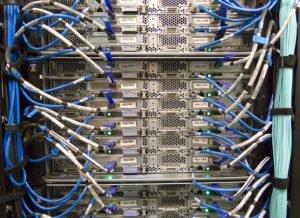
Knowing the basics of optical fiber allows one to know what applications it works best for.
We talk about fiber optics quite a bit on this blog, and while it’s common knowledge that fiber optic cables are a critical tool for networking purposes, many may not know what the science behind that technology actually is. Optical fiber is glass drawn out to a specific length and diameter, typically just slightly larger than a human hair, which can then be used to transmit light. That light transmission can be used for a number of applications, including sensors, visible light displays, and of course high-speed networking. Below, we break down why optical fiber is deployed, what the major kinds are, and what the applications may be.
Why Use Optical Fiber?
Compared to their metal counterparts like copper wiring, optical fiber is much more reliable, in part because of their immunity to any electromagnetic interference. Additionally, fiber optics allows the transmission of data across larger distances all while maintaining higher bandwidths as well. Fiber cables are also less susceptible to water damage than something like copper. Those features alone would make optical fiber a competitive force in the tech world, but fiber is also affordable and secure. One drawback to fiber is that there is a transmission loss over long enough distances, though this can be mitigated depending on the kind of fiber deployed. Let’s take a look at two major kinds of fiber and what they are used for.
Single Mode Optical Fibers
With single mode optical fibers, there’s a smaller diameter core which only allows for a single mode of light to get through. This reduces the amount of light leakage, which can go a long way in helping signals travel across long distances. Using lasers as the light source, single mode fiber is used for long distances, up to 40 miles, and typically is utilized by telecommunication companies, government agencies, and universities that have large campuses and big networks to match.
Multimode Optical Fibers
Bolstered by a larger diameter core, meaning more modes of light can pass through, multimode optical fibers are ideal when you need a larger amount of information to pass through. Multimode fibers, using LEDs or VCSELs as their light source, are typically limited to a length of 500 meters (1,640 feet). The higher rates of dispersion and attenuation lead to signal loss over longer distances, which is why these cables are typically utilized within data centers or for Local Area Network (LAN) purposes.
Get in Touch with FiberPlus
FiberPlus has been providing data communication solutions for over 25 years in the Mid Atlantic Region for a number of different markets. What began as a cable installation company for Local Area Networks has grown into a leading provider of innovative technology solutions improving the way our customers communicate and keeping them secure. Our solutions now include:
- Structured Cabling (Fiberoptic, Copper and Coax for inside and outside plant networks)
- Electronic Security Systems (Access Control & CCTV Solutions)
- Wireless Access Point installations
- Public Safety DAS – Emergency Call Stations
- Audio/Video Services (Intercoms and Display Monitors)
- Support Services
- Specialty Systems
- Design/Build Services
FiberPlus promises the communities in which we serve that we will continue to expand and evolve as new technology is introduced within the telecommunications industry.
Have any questions? Interested in one of our services? Call FiberPlus today 800-394-3301, email us at info@fiberplusinc.com, or visit our contact page. Our offices are located in the Washington, DC metro area, Richmond, VA, and Columbus, OH. In Pennsylvania, please call Pennsylvania Networks, Inc. at 814-259-3999.
Do you enjoy clicking “Like” and “Follow?” Be sure to click on our official Pinterest, Facebook, Twitter, and LinkedIn pages today!